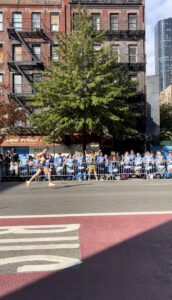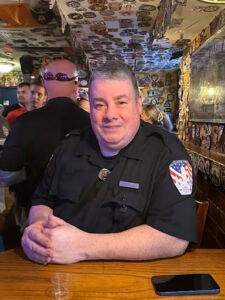First came the runners, and then, the conch.
Baby pink, its belly was glued to the mouth of a man procuring the seashell’s dull “wooooo.” Already, people smashed sticks against cowbells. A little girl wore a purple bow in her ponytail and waved silver pom-poms over the barricade.
At 9:51 a.m., the leaders of the Men’s Professional Wheelchair division rolled into Manhattan, their fourth borough of the morning. They were the first of the day’s marathoners to face the slight incline of First Avenue –– which here, any runner would tell you, was like a summit to Mount Everest.
Just then, the Fogo Azul women’s, trans, and non-binary drumline started playing.
“Aye aye aye,” an ultramarathoner from Brooklyn, Brigid Turner, said. She swayed her hips to the beat and waved to the leaders. “That just lit the block up!”
Every year on the first Sunday of November, the New York City Marathon brings out droves of New Yorkers to cheer on its 50,000-something runners. The race is part of the “Big-6,” runner-lingo for the World Marathon Majors: Tokyo, Berlin, London, Boston, Chicago and New York.
Turner, who previously ran all but Boston in the Big-6 marathons, and the Empire State Trail (591 miles from Buffalo to the West Side Highway), was not running this time. But Turner eagerly awaited the incoming runners.
“This is like waiting for Christmas morning!” someone from Turner’s party said. “Is it Christmas yet? Is it Christmas yet?”
Just then, above Turner’s head, an older man waved a Palestinian flag from his balcony — prompting a younger man, on the other side of First Avenue, to lean out his window and scream, “Don’t be a terrorist!”
The older man shook his head.
Beneath this spat, the first of the Professional Women runners at minute marker 1:33:13 ran through like gazelles. The Fogo Azul drumline and New Yorkers’ cheers intensified below.
“Everyone in the world runs this race,” Turner called up to them.
Then the Professional Men leaders began to emerge, and Turner went back to clanging her bell.

For marathoners like Sydney Divore, 32, it was this First Avenue stretch of cowbells and Gatorade cups, stacked like card tables, that helped her finish the race.
“The crowds of New York make it feel like you’re never really alone,” Divore said. “That was something you don’t usually expect at a race of this size.”
For other finishers, like Tom Burke, 35, pain and technical malfunctions proved harrowing throughout the morning. His wheelchair’s handrails broke several times.
“It was a character-building race,” Burke said, looking down at his medal and shaking his head. “But I ended up finishing with a personal best, so I’ll take it.”
All along the sidelines, people made signs as comedic relief from the 26.2 miles of endurance.
“The rats don’t run this city, you do,” one sign read. Another, made by a Bostonian named Chloe, 26, who would not give her last name so as not to ruin the vibe, read, “There’s a hot guy in front of you, run faster!”
The signs and overall spirit, as Finley Dale of Scotland, 71, saw it, were a testament to marathon culture overall. “It’s a great leveler,” Dale said. “There’s no hierarchy. Everybody’s the same. And everybody who finishes, whatever the time, has done well.”
By 1:15 p.m., a stream of runners emerged from the west side of Central Park –– where the race ended –– with shiny medals around their necks and orange ponchos clinging to their sweaty backs. Columbus Circle was packed shoulder to shoulder.
At the mouth of the subway leading to the C train Downtown, finisher Mohamed Oueslati, 37, of France, explained that it’s consistently the hardest marathon for him. The stretch of Fifth Avenue was a “horreur,” he wailed.
But he returned even after last year, when he could not get to Central Park’s Mile 26 from heat exhaustion. He explained that it was such a great loss that when he woke up at the side of the race last year, it crushed a part of his soul.
As a homeless man approached Oueslati in the subway platform, Oueslati gave him his apple and chips handed out at the finish line. Here, he gestured to that man’s suffering, which he was the only one on the subway platform to notice, a suffering greater than Oueslati’s own loss last year.
Then the C train to Downtown arrived with a hot flash of wind and the groan of its exhaust. Above the Columbus Circle station cowbells rang, as the rest of New York still celebrated its most sacred Sunday.
“Just to see people here, apart from the finish line,” Oueslati said, brushing tears from his eyelashes. “They’re streaked with something of humanity.”








